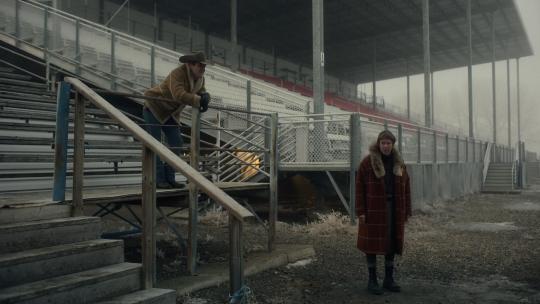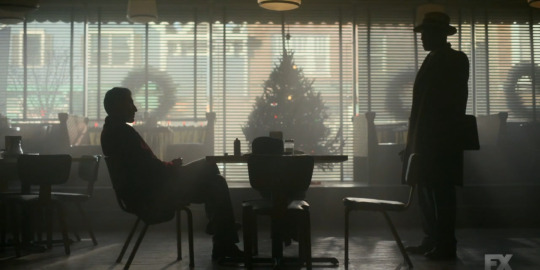#Peter Konczal
Text

Fargo
Season 5, “The Tiger”
Director: Dana Gonzales
DoP: Peter Konczal
#Fargo#The Tiger#Fargo S05E05#Season 5#Dana Gonzales#Peter Konczal#Jennifer Jason Leigh#Lorraine Lyon#Noah Hawley#FX#26 Keys Productions#The Littlefield Company#FXP#MGM Television#TV Moments#TV Series#TV Show#television#TV#TV Frames#cinematography#December 12#2023
26 notes
·
View notes
Text
youtube
Art21 proudly presents an artist segment, featuring Theaster Gates, from the "Chicago" episode in the ninth season of the "Art in the Twenty-First Century" series.
"Chicago " premiered in September 2016 on PBS. Watch now on PBS and the PBS Video app: https://www.pbs.org/video/art-21-chic...
Theaster Gates first encountered creativity in the music of Black churches on his journey to becoming an urban planner, potter, and artist. Gates creates sculptures out of clay, tar, and renovated buildings, transforming the raw material of the South Side into radically reimagined vessels of opportunity for the community.
Establishing a virtuous circle between fine art and social progress, Gates strips dilapidated buildings of their components, transforming those elements into sculptures that act as bonds or investments, the proceeds of which are used to finance the rehabilitation of entire city blocks. Many of the artist’s works evoke his African-American identity and the broader struggle for civil rights, from sculptures incorporating fire hoses, to events organized around soul food, and choral performances by the experimental musical ensemble Black Monks of Mississippi, led by Gates himself.
Learn more about the artists at:
https://art21.org/artist/theaster-gates/
CREDITS | Executive Producer: Eve Moros Ortega. Host: Claire Danes. Director: Stanley Nelson. Producer & Production Manager: Nick Ravich. Editor: Aljernon Tunsil. Art21 Executive Director: Tina Kukielski. Curator: Wesley Miller. Associate Producer: Ian Forster. Structure Consultant: Véronique Bernard. Director of Photography: Keith Walker. Additional Photography: Don Argott, Brian Ashby, Steve Delahoyde, Jeremy Dulac, Damon Hennessey, Sam Henriques, Ben Kolak, Christoph Lerch, Stephan Mazurek, Andrew Miller, Christopher Morrison, Leslie Morrison, Murat Ötünç, Logan Siegel, Stephen Smith, & Jamin Townsley. Assistant Camera: Kyle Adcock, Joe Buhnerkempe, Alex Klein, Ian McAvoy, Sean Prange, & Liz Sung. Sound: Sean Demers, Alex Inglizian, Hayden Jackson, İlkin Kitapçı, Joe Leo, Matt Mayer, John Murphy, Richard K. Pooler, & Grant Tye. Production Assistant: Hamid Bendaas, Emmanuel Camacho, Chad Fisher, Elliot Rosen, Stanley Sievers, Chris Thurston, & Steven Walsh.
Title/Motion Design: Afternoon Inc. Composer: Joel Pickard. Online Editor: Don Wyllie. Re-Recording Mix: Tony Pipitone. Sound Edit: Neil Cedar & Jay Fisher. Artwork Animation: Anita H.M. Yu. Assistant Editor: Maria Habib, Leana Siochi, Christina Stiles, & Bahron Thomas.
Host Introduction | Creative Consultant: Tucker Gates. Director of Photography: Pete Konczal. Second Camera: Jon Cooper. Key Grip: Chris Wiesehahn. Gaffer: Jesse Newton. First Assistant Camera: Sara Boardman & Shane Duckworth. Sound: James Tate. Set Dresser: Jess Coles. Hair: Peter Butler. Makeup: Matin. Production Assistant: Agatha Lewandowski & Melanie McLean. Editor: Ilya Chaiken.
Artworks Courtesy of: Nick Cave; Theaster Gates; Barbara Kasten; Chris Ware; BAM Hamm Archives; Bortolami Gallery; Cranbrook Art Museum; Margaret Jenkins Dance Company; The New Yorker magazine and Condé Nast; James Prinz Photography; Jack Shainman Gallery; Sara Linnie Slocum; Chris Strong Photography; & White Cube. Acquired Photography: Sara Pooley; The Art Channel/Bobbin Productions; & University Art Museum, California State University Long Beach.
Special Thanks: The Art21 Board of Trustees; 900/910 Lake Shore Drive Condominium Association; Michael Aglion; Ellen Hartwell Alderman; Adam Baumgold Gallery; Naomi Beckwith; Biba Bell; Stefania Bortolami; Kate Bowen; Pat Casteel; Chicago Embassy Church; Coachman Antique Mall; Maria J. Coltharp; John Corbett; Department of Theatre & Dance, Wayne State University; Detroit School of Arts; Christina Faist; Bob Faust; Martina Feurstein; Julie Fracker; William Gill; Graham Foundation; Jen Grygiel; Sarah Herda; Jennon Bell Hoffmann; Sheree Hovsepian; Institute of Contemporary Art at the University of Pennsylvania; Istanbul Biennial; Nicola Jeffs; Jenette Kahn; Jill Katz; Alex Klein; Kunsthaus Bregenz; Jon Lowe; Sheila Lynch; Mana Contemporary Chicago; Christine Messineo; Laura Mott; Deborah Payne; Bishop Ed Peecher; Lisa Pooler; Rebuild Foundation; Diana Salier; Tim Samuelson; Amy Schachman; Zeynep Seyhun; Keith Shapiro; Alexandra Small; Jacqueline Stewart; Hamza Walker; Clara Ware; Marnie Ware; & Steve Wylie.
Additional Art21 Staff: Maggie Albert; Lindsey Davis; Joe Fusaro; Jessica Hamlin; Jonathan Munar; Bruno Nouril; Pauline Noyes; Kerri Schlottman; & Diane Vivona.
Public Relations: Cultural Counsel. Station Relations: De Shields Associates, Inc. Legal Counsel: Albert Gottesman.
Dedicated To: Susan Sollins, Art21 Founder.
Major support for Season 8 is provided by National Endowment for the Arts, PBS, Lambent Foundation, Agnes Gund, The Andy Warhol Foundation for the Visual Arts, and The Anna-Maria and Stephen Kellen Foundation.
©2016 Art21, Inc.
0 notes
Link
A FEW YEARS before Jay Hammond, a Republican, was elected to serve as Alaska’s governor in 1974, he worked as mayor of the small borough of Bristol Bay. There, he watched as nearly all of his town’s rich salmon resources were extracted from the region, with virtually none of the profits or job opportunities going to locals. He fashioned the idea of a 3 percent tax on fish catch, and using the money raised for an investment fund that would pay Bristol Bay residents an annual dividend from its returns.
Voters rejected Hammond’s idea, but he’d have several more opportunities to promote it in the following years. As governor, in 1976, he pushed for a constitutional amendment that would direct 25 percent of all lease sale payments and oil royalties to a fund that could only be used for income-generating investments. Hammond originally kept quiet about his desire to direct those returns back to citizens, and it was understood primarily as a proposal to prevent the waste of oil revenue. But after the amendment passed by a 2-to-1 margin, Hammond made it his central mission to push for the citizens’ dividend idea. His persistence paid off and in 1982, Alaskans received their first check from the so-called Permanent Fund, a dividend that has flowed annually ever since.
At the end of 2017, over 600,000 Alaskan citizens received dividends of $1,100. In prior years, checks have been as high as $2,000 per person. The fund is massively popular — recent polling showed that Republicans, Democrats, and independents all would rather pay higher income taxes to reduce the deficit than see their annual dividend cut. In no small part due to the Permanent Fund, Alaska is the most economically equal state in the country.
“It’s certainly the most popular political program in Alaska,” Bill Wielechowski, a Democratic state senator, told The Intercept. “It’s a really significant amount of money and has a huge impact. There have been studies that show the majority of people put it towards savings and paying ordinary bills.”
The Alaska Permanent Fund is what’s known as a “social wealth fund” — also sometimes called a “sovereign wealth fund” or a “citizens’ wealth fund.” There are more than 70 such funds across the world, in countries like Australia, Japan, New Zealand, Qatar, and Norway. The number of social wealth funds has risen considerably since 2000, and a new report produced by Matt Bruenig, founder of the crowd-funded socialist think tank the People’s Policy Project, advocates for expanding Alaska’s model to create a national social wealth fund in the United States. Doing so, Bruenig argues, may be the best shot Americans have to stop a decades-long trend of accelerating inequality.
Bruenig dubs his idea the “American Solidarity Fund.” The government would gradually accumulate assets such as stocks, bonds, and real estate, and as the value of the publicly managed assets increases, the value of the shares would also rise. Citizens would receive a “universal basic dividend” every year from the income earned from the fund’s investments.
While Alaska’s Permanent Fund was built around a rich natural resource, Bruenig points to Sweden’s short-lived experiment with a social wealth fund in the 1980s, where Swedes used taxes on corporate profits to fill it up. (Conservative legislators ended Sweden’s fund in 1991.)
Bruenig explores five different ways to bring in assets to a national U.S. fund, ranging from voluntary contributions from the superrich to a host of new taxes and fees. While he acknowledges many different types of levies could work, he focuses on wealth taxes, like market capitalization taxes, financial transaction taxes, and steeper inheritance taxes.
Unlike Alaska’s model, which does not grant dividend recipients any formal ownership, Bruenig proposes giving every qualifying citizen one nontransferable share of the fund. The idea is to give citizens some power they could then collectively exert over corporate board decision-making. Individuals could also track their share online, similar to the way individuals can track their growing capital investments on Vanguard. “This is partially a communications gimmick,” he acknowledges. “But no more so than many of the hyper-abstracted ownership gimmicks that already exist in the country’s capital markets.”
Also unlike Alaska’s model, which distributes dividends to all citizens, Bruenig proposes issuing dividends to every citizen above age 17. (He advocates monthly child allowances for families with children, not administered through a social wealth fund.)
The national social wealth fund idea has gotten some high-profile attention, including in Hillary Clinton’s recent memoir, “Hard Choices.” Clinton said she first learned about the idea after reading a 2014 book published by Peter Barnes, an entrepreneur who also proposed a national fund like the model in Alaska. “Besides cash in people’s pockets, it would also be a way of making every American feel more connected to our country and to one another—part of something bigger than ourselves,” she wrote. “I was fascinated by this idea, as was my husband, and we spent weeks working with our policy team to see if it could be viable enough to include in my campaign.” Clinton said they shelved the “Alaska for America” idea when they “couldn’t make the numbers work.”
Still, the political appeal of a policy like this might be hard to shelve permanently. Whether or not robots are really coming for our jobs remains hotly disputed, but what’s not up for debate is that voters increasingly fear it is happening and want political solutions to it. In 2015, Pew Research Center found that 65 percent of Americans anticipate that robots and computers will “definitely” or “probably” do the work currently under human control within the next 50 years. Politicians will be on the lookout for ideas to ease public insecurity.
Bruenig also points to the problem of growing wealth inequality, one that has shown no sign of reversing course. Analyzing the Survey of Consumer Finances, he found that between 2007 and 2016, the average wealth of the top 1 percent increased by $4.9 million as the wealth of the median family declined by $42,000.The top 1 percent of families, he adds, owns more wealth than the bottom 95 percent combined.
By putting more wealth under government control, Bruenig reasons, the U.S. can then redistribute it back to the people.
Peter Barnes, author of “With Liberty and Dividends for All” — the 2014 book Clinton cited in her memoir — told The Intercept that any version of a social wealth fund should be expected to start very small, but grow over time. “Getting it started would be a breakthrough,” he said. “Social Security started in 1935 at a 1 percent payroll tax and the benefits for the elderly were trivial at the beginning.”
Still, not all who’ve explored the idea see it as the right move for the United States to address its growing inequality and insecurity. Mike Konczal, a fellow at the left-leaning Roosevelt Institute, is skeptical about establishing a U.S. social wealth fund, and says it’s not only a particularly difficult way to achieve the desired redistributive goals, but could also easily have negative effects.
“If you’re thinking that the government should spend more on ‘Medicare for All,’ or for a basic income, then we can both tax wealthy people and capital income more,” he said. “If a sovereign wealth fund reinforces the deficit mentality that we have to save money to spend money, or we can’t spend money if we don’t have a special fund, that would be counterproductive.”
Another problem Konczal highlights is that social wealth funds are more difficult tools to capture privately held wealth. “This is a hard way to get at a lot of income. Koch Industries, for example, would not interact with a fund like this.” Rather than a market capitalization tax on public companies, Konczal says, why not just tax all companies through a higher corporate income tax?
And lastly, with regard to tying citizenship to capital income, he worries this could reinforce, rather than weaken, the view that the economy should only work for shareholders. Would making capitalists out of everybody drive up support for deregulating Wall Street or repealing environmental protections?
Continue Reading ...
Phroyd
16 notes
·
View notes
Text

Fargo
Season 5, “The Tender Trap”
Director: Dana Gonzales
DoP: Peter Konczal
#Fargo#The Tender Trap#Fargo S05E06#Season 5#Dana Gonzales#Peter Konczal#Jon Hamm#Roy Tillman#Sam Spruell#Ole Munch#Noah Hawley#Bob DeLaurentis#FX#26 Keys Productions#The Littlefield Company#FXP#MGM Television#TV Moments#TV Series#TV Show#television#TV#TV Frames#cinematography#December 19#2023
14 notes
·
View notes
Text

Fargo
Season 5, “The Tiger”
Director: Dana Gonzales
DoP: Peter Konczal
#Fargo#The Tiger#Fargo S05E05#Season 5#Dana Gonzales#Peter Konczal#Juno Temple#Dorothy Lyon#Nadine Tillman#Sienna King#Scotty Lyon#Noah Hawley#FX#26 Keys Productions#The Littlefield Company#FXP#MGM Television#TV Moments#TV Series#TV Show#television#TV#TV Frames#cinematography#December 12#2023
9 notes
·
View notes
Text

Fargo
Season 5, “The Tender Trap”
Director: Dana Gonzales
DoP: Peter Konczal
#Fargo#The Tender Trap#Fargo S05E06#Season 5#Dana Gonzales#Peter Konczal#Jennifer Jason Leigh#Lorraine Lyon#Noah Hawley#Bob DeLaurentis#FX#26 Keys Productions#The Littlefield Company#FXP#MGM Television#TV Moments#TV Series#TV Show#television#TV#TV Frames#cinematography#December 19#2023
2 notes
·
View notes
Photo

Fargo
Season 4, “The Birthplace of Civilization“
Director: Dana Gonzales
DoP: Peter Konczal
#Fargo#The Birthplace of Civilization#Fargo S04E05#Season 4#Dana Gonzales#Peter Konczal#Jason Schwartzman#Josto Fadda#Ben Whishaw#Rabbi Milligan#Rodney L. Jones III#Satchel Cannon#Noah Hawley#Francesca Sloane#FX#MGM Domestic Television Distribution#26 Keys Productions#The Littlefield Company#FXP#MGM Television#TV Moments#TV Series#TV Show#television#TV#TV Frames#cinematography#October 18#2020
13 notes
·
View notes
Photo

Fargo
Season 4, “The Birthplace of Civilization“
Director: Dana Gonzales
DoP: Peter Konczal
#Fargo#The Birthplace of Civilization#Fargo S04E05#Season 4#Dana Gonzales#Peter Konczal#Gaetano Bruno#Constant Calamita#Glynn Turman#Doctor Senator#Noah Hawley#Francesca Sloane#FX#MGM Domestic Television Distribution#26 Keys Productions#The Littlefield Company#FXP#MGM Television#TV Moments#TV Series#TV Show#television#TV#TV Frames#cinematography#October 18#2020
5 notes
·
View notes